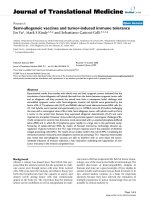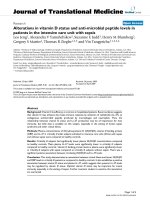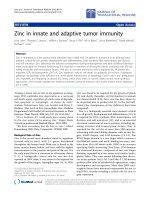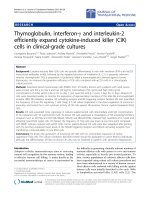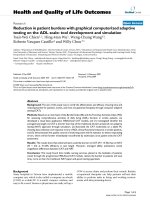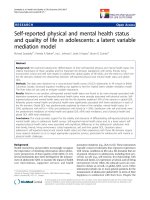báo cáo hóa học: " Reaching in reality and virtual reality: a comparison of movement kinematics in healthy subjects and in adults with hemiparesis" pdf
Bạn đang xem bản rút gọn của tài liệu. Xem và tải ngay bản đầy đủ của tài liệu tại đây (300.34 KB, 7 trang )
BioMed Central
Page 1 of 7
(page number not for citation purposes)
Journal of NeuroEngineering and
Rehabilitation
Open Access
Research
Reaching in reality and virtual reality: a comparison of movement
kinematics in healthy subjects and in adults with hemiparesis
Antonin Viau
1,2
, Anatol G Feldman
2,3
, Bradford J McFadyen
4
and
Mindy F Levin*
2,5
Address:
1
School of Rehabilitation, Faculty of Medicine, University of Montreal, Canada,
2
Center for Interdisciplinary Research in Rehabilitation
(CRIR), 6300 Darlington, Montreal, Quebec, Canada,
3
Department of Physiology, University of Montreal, Canada,
4
Center for Interdisciplinary
Research in Rehabilitation and Social Integration (CIRRIS), Department of Rehabilitation, Laval, Canada and
5
School of Physical and
Occupational Therapy, McGill University, Canada
Email: Antonin Viau - ; Anatol G Feldman - ;
Bradford J McFadyen - ; Mindy F Levin* -
* Corresponding author
arm reachingprehensionrehabilitationstroketherapeutic approachhemiplegia
Abstract
Background: Virtual reality (VR) is an innovative tool for sensorimotor rehabilitation increasingly being employed in
clinical and community settings. Despite the growing interest in VR, few studies have determined the validity of
movements made in VR environments with respect to real physical environments. The goal of this study was to compare
movements done in physical and virtual environments in adults with motor deficits to those in healthy individuals.
Methods: The participants were 8 healthy adults and 7 adults with mild left hemiparesis due to stroke. Kinematics of
functional arm movements involving reaching, grasping and releasing made in physical and virtual environments were
analyzed in two phases: 1) reaching and grasping the ball and 2) ball transport and release. The virtual environment
included interaction with an object on a 2D computer screen and haptic force feedback from a virtual ball. Temporal and
spatial parameters of reaching and grasping were determined for each phase.
Results: Individuals in both groups were able to reach, grasp, transport, place and release the virtual and real ball using
similar movement strategies. In healthy subjects, reaching and grasping movements in both environments were similar
but these subjects used less wrist extension and more elbow extension to place the ball on the virtual vertical surface.
Participants with hemiparesis made slower movements in both environments compared to healthy subjects and during
transport and placing of the ball, trajectories were more curved and interjoint coordination was altered. Despite these
differences, patients with hemiparesis also tended to use less wrist extension during the whole movement and more
elbow extension at the end of the placing phase.
Conclusion: Differences in movements made by healthy subjects in the two environments may be explained by the use
of a 2D instead of a 3D virtual environment and the absence of haptic feedback from the VR target. Despite these
differences, our findings suggest that both healthy subjects and individuals with motor deficits used similar movement
strategies when grasping and placing a ball in the two reality conditions. This suggests that training of arm movements in
VR environments may be a valid approach to the rehabilitation of patients with motor disorders.
Published: 14 December 2004
Journal of NeuroEngineering and Rehabilitation 2004, 1:11 doi:10.1186/1743-0003-1-11
Received: 29 November 2004
Accepted: 14 December 2004
This article is available from: />© 2004 Viau et al; licensee BioMed Central Ltd.
This is an Open Access article distributed under the terms of the Creative Commons Attribution License ( />),
which permits unrestricted use, distribution, and reproduction in any medium, provided the original work is properly cited.
Journal of NeuroEngineering and Rehabilitation 2004, 1:11 />Page 2 of 7
(page number not for citation purposes)
Introduction
Virtual reality (VR) is a computer-based, multisensory
interactive simulation occurring at the same speed and
time as events in the physical world. Different levels of
immersion can be achieved ranging from complete 3D
(cave, head-mounted display) to partial 2D (computer
display, TV screen) with different hardware configura-
tions. Interface devices (computer mouse, joystick, force
sensor, cyberglove) allow the user to move in and interact
with objects in the virtual environment. Of crucial rele-
vance to rehabilitation is the potential for increasing the
user's level of interaction with their real physical environ-
ment so as to maximize their return to community life [1].
The efficacy of using VR to retrain movement and the issue
of whether training in a virtual environment will transfer
to meaningful function in the real physical world has
been explored in a number of studies with encouraging
early results [2-4].
Neurophysiologists and rehabilitation specialists like
physical and occupational therapists are beginning to be
interested in VR as a tool to study motor control and to
evaluate and treat motor deficits secondary to central
nervous system lesions such as stroke [5]. The use of vir-
tual computer-based interventions for telerehabilitation is
also gaining in popularity because of the possibility of
providing extended practice in the patient's own home or
community environment [6,7]. The advantage of using VR
in community, clinical and laboratory settings is that by
virtue of its programmability, environments and the
amount and type of feedback can be modified according
to the user's motor capacities, motivation and therapeutic
goals [5,8]. In addition, sensory parameters of the envi-
ronment can be creatively adapted to evoke responses to a
larger number of situations in a shorter amount of time
than is available in physical set-ups. For example, in
research studies, when determining the capacity to reach
and grasp static targets, methodologies are often limited
to one or two tasks because of the inability to easily adapt
the experimental hardware. VR permits the use of more
dynamic experimental set-ups in which object locations
and orientations can be reliably and rapidly modified.
This study focused on the possibility of using virtual envi-
ronments for the retraining of arm motor function in indi-
viduals with hemiparesis due to stroke. Major barriers to
arm motor recovery after stroke are coordination deficits
and the use of maladaptive movement strategies for reach-
ing and grasping. Patient motivation and movement rep-
etition are key factors in motor recovery [9-12]. Current
practice of rehabilitation of reaching deficits after stroke is
based on movement repetition of targeted tasks. However,
improvements in tasks practised in clinical settings have
not been shown to have adequate carry over into real
world activities of daily living [10]. One of the factors that
may decrease the real world relevancy of practice in the
clinical setting is the lack of attention to the retraining of
varied goal-directed, effector-relevant whole arm move-
ments. VR is an ideal medium in which to create such
practise environments that have the advantage of provid-
ing additional motivation to patients to perform repeti-
tive movement and can be available in the home or
community following formal rehabilitation [13]. Indeed,
some studies have reported that motor gains achieved by
patients with stroke in VR environments may transfer to
physical tasks and be measurable using common clinical
scales [2,5,14].
Despite the growing interest in the use of VR for motor
retraining, it is not known if movements involving reach-
ing and grasping objects in VR environments are per-
formed in a manner similar to those done in the physical
world. Thus, the goal of this study was to validate VR as a
tool for studying reaching and grasping in healthy sub-
jects and in individuals with hemiparesis by comparing
movement kinematics of identical tasks made in a physi-
cal and a virtual environment. Since reaching and grasp-
ing deficits have been well characterized in individuals
with hemiparesis [15-17], the purpose of the study was
not to compare movements between groups but to estab-
lish the validity of using a VR environment for the study
of movement in each group. Preliminary results have
appeared in abstract form [18].
Table 1: Demographic characteristics and clinical scores of participants with hemiparesis
Subject Age (yrs)/sex Time since injury (months) Type of lesion CM: arm CM: hand
1 63/M 28 Temporo-parietal 6 6
2 42/F 34 Parietal 7 6
3 27/F 63 Parietal 7 3
4 51/F 51 Frontal 7 6
5 31/F 33 Temporo-parietal 6 6
6 47/M 64 Fronto-temporo-parietal 7 6
7 81/M 33 Temporo-parietal 7 6
Mean ± SD 48.9 ± 18.6 43.7 ± 15.3 6.7 ± 0.5 5.6 ± 1.1
M = male, F = female, CM = Chedoke-McMaster stroke assessment
Journal of NeuroEngineering and Rehabilitation 2004, 1:11 />Page 3 of 7
(page number not for citation purposes)
Methods
Eight healthy subjects (4 males and 4 females; 56.8 ± 17.1
years) and 7 adults with hemiparesis (3 males and 4
females; 48.9 ± 18.6 years) with no prior experience with
VR participated in the study. Potential participants were
identified from discharge lists of Montreal area rehabilita-
tion centres. Out of 17 medical charts screened, 12
patients met eligibility requirements according to study
inclusion and exclusion criteria. Patients were included if
they were under 60 years old, had sustained a single, non-
traumatic unilateral stroke in the territory of the left mid-
dle cerebral artery and had arm paresis (3/7 for the hand
and 6/7 for the arm on the Chedoke-McMaster Stroke
Assessment Scale [19] (Table 1). Patients were excluded if
they had cerebellar or brain stem lesions, shoulder pain or
other neurological/orthopaedic conditions affecting
reaching ability, visual field deficits, uncorrected prob-
lems of visual acuity or severe perceptuo-cognitive deficits
(heminegligence, ataxia, receptive aphasia) determined
by standard clinical tests. Of these 12 individuals, 10
expressed willingness to participate. After obtaining
informed consent approved of by the institutional Ethics
Committee, they were assessed by a physical therapist and
3 individuals were excluded because of inability to per-
form the task. Healthy subjects were recruited from the
community. They had no orthopaedic or neurological dis-
ease. All patients had been discharged from all in- or out-
patient clinical services.
Subjects performed 6 trials each of two near identical tasks
set in the physical world or in a virtual environment. In
both tasks, seated subjects grasped a real or virtual ball of
7 cm diameter with their right hand, beginning from the
edge of a real or virtual table, reached forward by leaning
the trunk and then placed the ball within a 2 cm × 2 cm
yellow square on a real or virtual target (Figure 1). Care
was taken to set-up the physical task so that the initial
position of the arm, ball, table and wall were identical to
that of the virtual task. Thus, in both environments, the
initial position of the arm was about 0° flexion, 30°
abduction and 0° external rotation (shoulder), 80° flex-
ion and 0° supination (elbow) with the wrist and hand in
the neutral position. The fingers were slightly flexed. The
initial position of the ball was 13 cm in front of the right
shoulder, 7 cm above and 3 cm to the left of the subject's
hand. The target was placed 31 cm in front of the shoul-
der, 12.5 cm above and 14 cm to the right of the initial
position of the ball (Figure 1).
For the VR task, the ball appeared on a computer screen
inside a cube that also displayed the position of the sub-
ject's hand. The VR target was the upper right back corner
of the cube. Subjects had to grasp the virtual ball, trans-
port it to the VR target and release it. The VR environment
was displayed in 2 dimensions (2D) on a computer screen
placed 75 cm in front of subject's manubrium (Figure 1).
The virtual representation of the subject's hand was
Experimental set-upFigure 1
Experimental set-up. Physical (a) and virtual reality condition (b).
Journal of NeuroEngineering and Rehabilitation 2004, 1:11 />Page 4 of 7
(page number not for citation purposes)
obtained using a 22 sensor fibre optic glove (Cyberglove,
Immersion Corp.) and an electromagnetic sensor (Fas-
trak, Polhemus Corp.) that was used to orient the glove in
the 2D environment. Data from these devices were syn-
chronized in real time. To enable the subject to "feel" the
virtual ball, a prehension force feedback device (Cyber-
grasp, Immersion Corp.) was fitted to the dorsal surface of
the hand. The Cybergrasp delivered prehension force
feedback in the form of extension forces to the distal pha-
lanxes of the thumb and each finger. Forces applied to the
fingers were calibrated for each subject while he/she was
wearing the Cyberglove. These ranged from 6 to 8 N per
finger and all subjects perceived that they were holding a
spherical object in their hand.
Prior to data collection, all participants practised the tasks
in physical and virtual conditions (20 – 40 min). To better
compare the participants' performance in the two envi-
ronments, the glove and grasp devices were worn on the
hand in both conditions (Figure 1).
Kinematic data from the right arm were recorded with 6
infrared-emitting diodes (IREDs) placed on the distal
phalanx of the index and thumb, the distal head of the
first metacarpal, the radial styloid process, the lateral
epicondyle of the humerus and the acromion (120 Hz,
Optotrak Motion Analysis System, Northern Digital
Corp.).
Each trial was divided in two phases: 1) reaching and
grasping the ball and 2) ball transport and release. For the
first movement phase, 4 temporal and 4 spatial parame-
ters of reaching and grasping were determined. Temporal
parameters were movement time, time to peak wrist
velocity (RPV), time to maximal hand aperture (RMGA),
and the delay between them (RPV-RMGA). Spatial param-
eters were endpoint path curvature, maximal grip aper-
ture, angular ranges of joint motion and elbow-shoulder
interjoint coordination [16]. For the second movement
phase, we determined one temporal (movement time)
and 4 spatial (endpoint path curvature, trajectory length,
angular ranges of joint motion and interjoint coordina-
tion) parameters.
Movement onsets and offsets of each phase were defined
as the times at which the tangential velocity of the IRED
on the index finger surpassed and remained above or fell
and remained below 10% of the maximal peak velocity
respectively. The temporal parameters (time to peak wrist
velocity, time to maximal grip aperture) were normalized
to movement time and the delay between them was calcu-
lated. For the spatial parameters, the curvature of the tra-
jectory of the IRED on the index finger was estimated as
the ratio between the actual trajectory length and a
straight line segment between the initial and final posi-
tions [20]. Joint angular excursions were expressed as the
difference in degrees between the angle at the beginning
and the end of movement, according to movement times
defined above. For interjoint coordination, we deter-
mined the slopes between elbow extension and 1) shoul-
der flexion and 2) shoulder abduction. The slope of the
angle-angle relationship describes the relative contribu-
tion of each joint throughout the movement where a
slope of 1 indicates an equal contribution of each joint.
Slopes greater than 1 indicated a larger contribution of
elbow extension than shoulder movement and vice versa.
The relationship between both angles was considered lin-
ear since all regression correlation coefficients were = 0.8.
However, since a linear approximation was used, the
Table 2: Comparisons between reality conditions for the first phase of movement: reaching and grasping the ball.
Healthy Stroke
Physical condition VR condition Physical condition VR condition
Mean SD Mean SD Mean SD Mean SD
Temporal parameters
Movement time – onset to grasping (s) 0.68 0.17 0.95 0.35 1.23† 0.27 1.43† 0.41
RPV (%) 44.9 10.4 41.8 6.1 34.3 12.6 40.8 2.9
RMGA (%) 72.5 12.5 60.9 11.8 73.5 16.1 65.3 9.1
Delay between RPV and RMGA (%) 31.6 16.6 19.2 10.7 34.5 15.0 24.3 8.1
Spatial parameters
Curvature index 1.39 0.16 1.62 0.44 1.76 0.62 1.97 0.86
Wrist extension at grasping (°) 1.4 9.1 -3.9 8.2 12.1 2.2 4.5 14.1
Slope elbow extension/shoulder flexion 0.70 0.34 0.60 0.26 0.53 0.33 0.47 0.27
Slope elbow extension/shoulder abduction 2.30 2.02 2.31 2.54 2.65 1.66 2.30 1.26
Maximal grip aperture (mm) 95.7 16.4 90.2 20.5 89.8 20.2 84.9 19.3
RPV = relative time to peak velocity of the wrist; RMGA = relative time to maximal grip aperture; VR = virtual reality
† Significant difference between groups, Kruskal-Wallis, p < 0.05
Journal of NeuroEngineering and Rehabilitation 2004, 1:11 />Page 5 of 7
(page number not for citation purposes)
slope provides only a general estimate of the contribution
of each angle.
Statistical analysis
Both parametric and non-parametric statistics were used.
For within-group comparisons between the two condi-
tions of reality, Student t-tests were used. However, since
variances were not homogeneous (Levene's test) for
healthy subjects and participants with hemiparesis, non-
parametric tests were used for between-group
comparisons (Kruskal-Wallis ANOVA). A significance
level of p < 0.05 was used, adjusted for multiple compari-
sons by type using the Bonferroni correction.
Results
All healthy subjects and participants with mild upper limb
motor deficits were able to reach, grasp, transport, place
and release the virtual ball using movement strategies that
were similar to those used for the physical ball (Tables 2
and 3). Arm movement trajectories (Figure 2) were
smooth and followed similar paths for movements made
in both environments for both subject groups. Trajectory
lengths were similar in both conditions for healthy sub-
jects (289 ± 28 mm in real compared to 302 ± 55 mm in
VR) and for participants with hemiparesis (251 ± 25 mm
in real compared to 260 ± 30 mm in VR).
In healthy subjects, the temporal and spatial aspects of the
two phases of the task were almost identical between the
physical and virtual conditions (Tables 2, 3). However,
there was a non-significant tendency to make movements
more slowly and to use less wrist extension for grasping
during the first phase of the movement (reaching and
grasping the ball) in the virtual condition (Table 2). Dur-
ing the second phase, healthy subjects used significantly
less wrist extension (paired t-test, p < 0.05) and more
elbow extension (paired t-test, p < 0.05) to place the ball
on the virtual vertical surface (Table 3, Figure 3). In these
subjects, there were no other differences between any
Table 3: Comparisons between reality conditions for the second phase of movement: ball transport and release
Healthy Stroke
Physical condition VR condition Physical condition VR condition
Mean SD Mean SD Mean SD Mean SD
Temporal parameters
Movement time – onset to placing (s) 0.84 0.29 1.18 0.31 1.49† 0.45 2.28† 0.82
Spatial parameters
Curvature index 1.14 0.03 1.23 0.29 1.37† 0.27 1.42 0.57
Wrist extension at placing (°) 18.2 12.1 4.0* 8.1 20.3 8.2 6.4 16.0
Elbow extension (°) 25.6 6.9 38.4* 10.9 26.9 11.0 37.3 19.6
Shoulder flexion (°) 24.8 5.2 33.0 7.1 28.4 4.9 35.5 18.2
Shoulder abduction (°) 13.6 5.2 16.4 4.6 18.5 6.9 20.7 8.9
Slope elbow extension/shoulder flexion 1.08 0.08 1.21 0.16 1.01 0.26 1.18 0.15
Slope elbow extension/shoulder abduction 2.36 0.76 2.88 1.19 1.51† 0.69 1.48† 0.51
* Significant difference between reality conditions, Student t-tests with Bonferroni correction (p < 0.05/4 angles = 0.013); VR = virtual reality
† Significant difference between groups, Kruskal-Wallis, p < 0.05
Mean endpoint (marker on the index finger) trajectories for the two phases of the movement task for one healthy subject in the two reality conditionsFigure 2
Mean endpoint (marker on the index finger) trajectories for
the two phases of the movement task for one healthy subject
in the two reality conditions.
Journal of NeuroEngineering and Rehabilitation 2004, 1:11 />Page 6 of 7
(page number not for citation purposes)
other temporal or spatial parameter for both movement
phases (peak wrist velocity, relative time to peak wrist
velocity, timing of maximal grip aperture, trajectory curva-
ture or interjoint coordination).
Movements made by individuals with hemiparesis in the
physical environment differed from those made by
healthy subjects in three ways. In both phases, move-
ments were significantly slower and in the second phase,
trajectories were more curved and interjoint coordination
was altered (Tables 2 and 3). In particular, the slope of the
relationship between elbow extension/shoulder abduc-
tion was lower than in healthy subjects during the second
phase of the movement (p < 0.02, Figure 3). This decrease
in slope was due to a more abducted position of the
shoulder in the patient group. Despite these differences,
patients showed tendencies similar to healthy subjects
when reaching and grasping in the VR environment com-
pared to the real environment (Tables 2, 3). They tended
to decrease the speed of movements made in VR com-
pared to the physical environment, to use less wrist exten-
sion in both movement phases and to use more elbow
extension in the second phase of the movement. In addi-
tion, 5 out of 7 participants with hemiparesis significantly
decreased the wrist extension while 4 increased elbow
extension at the end of the second phase of the movement
(at the time of placing the ball) in the VR condition.
Discussion
The similarity in movement kinematics between physical
and virtual reaching and grasping suggests that virtual
reality may be an effective environment for rehabilitation.
Interest in training in virtual environments is increasing
amongst rehabilitation professionals in light of recent evi-
dence suggesting that neuronal recovery after stroke-
related brain damage critically depends on the motivation
of the individual and the intensity of training [10,11]. Vir-
tual reality represents a novel training environment in
which a wide variety of tasks can be easily practiced. It is
also becoming increasingly accessible with the advent of
home-based computers and telerehabilitation technology
[7]. Thus, the demonstration that movements practiced in
a virtual environment are kinematically similar to
movements with physical objects is essential to ensure the
transfer of training benefits to the real-life situation.
Our results show that subjects tended to decrease wrist
extension and increase elbow extension in the virtual
compared to the physical condition. Two principal factors
may explain those differences: the absence of depth per-
ception in the VR condition and the absence of tactile
feedback at the end of the reach.
Binocular vision enables humans to perceive depth in a 3
dimensional (3D) environment. This faculty is called ster-
eopsis (for a review see [21]). Since the VR condition in
our experimental set-up was a 3D task presented on a 2D
display, the results can be compared with those investigat-
ing reaching and grasping movements made under
conditions of monocular vision in which depth percep-
tion is reduced. Indeed, such studies have shown that
reaching and grasping movements are characterized by
shorter movement time and shorter relative time to maxi-
mal grip aperture [22].
The difference in depth perception in the 2D virtual envi-
ronment may also be responsible for the tendency to
increase elbow extension in both groups. Previous studies
have shown that fine motor corrections are produced by
distal joints [23]. The 2D display resulted in the subject
underestimating the real distance to the wall so that dur-
ing the course of the second phase of the movement, the
subject had to compensate by increasing the extension of
the limb until the screen display indicated that the ball
had reached the target distance. This caused a slight
change in strategy for the second phase of the movement
requiring an increase in the amount of elbow extension.
Participants with hemiparesis showed the same tenden-
cies as the healthy group but differences were not
Interjoint coordinationFigure 3
Interjoint coordination. Relationship between elbow exten-
sion and shoulder horizontal adduction (mean traces per
condition) during the second phase of the movement (plac-
ing) for both conditions in two healthy subjects (A,B) and in
two individuals with hemiparesis (C,D). In all examples, sub-
jects used more elbow extension in the virtual reality
condition.
Journal of NeuroEngineering and Rehabilitation 2004, 1:11 />Page 7 of 7
(page number not for citation purposes)
significant due to subject variability. Changes in motor
patterns may be avoided by using 3D immersive environ-
ments, such as those visualized through a head-mounted
display.
The absence of depth perception cannot explain the
decrease of wrist extension at the end of the second phase
of the movement in VR compared to the physical condi-
tion. A more likely explanation involves the type of haptic
feedback provided to the subject. In the physical condi-
tion, subjects had to extend the wrist so that the ball and
not their fingers would make contact with the target. In
the VR condition, wrist extension was not necessary
because subjects only had to place the ball at the coordi-
nates of the virtual wall without encountering a physical
barrier. To avoid such differences between physical and
VR environments, relevant haptic feedback is necessary to
indicate contact of the hand with the object or target.
Another way is to integrate physical objects into the VR
environment such as the manipulation of a real paper
envelope in real-time in a VR environment [6], or the
mimicking of irregularities in a walkway with a multi-
dimensional movement platform [24,25].
Overall, the finding that both healthy subjects and indi-
viduals with motor deficits used similar movement
strategies in a physical and a limited virtual environment
suggests that VR technology is a valuable tool for studying
and retraining reaching, grasping and placing movements.
Whether movement kinematics may be improved with
the use of interfaces providing stereopsis and more rele-
vant haptic feedback should be investigated by comparing
movements made in immersive to those made in non-
immersive virtual environments.
Acknowledgements
Source of support: Canadian Foundation for Innovation, Canadian Insti-
tutes of Health Research, AV received a summer research scholarship from
the Université de Montréal.
Some of this work was presented at the XVth Congress of ISEK, Boston,
June 18–21, 2004
References
1. Stanton D, Foreman N, Wilson P: Uses of virtual reality in clinical
training: developing the spatial skills of children with mobil-
ity impairments. In In Virtual Environments in Clinical Psychology and
Neuroscience: Methods and Techniques in Advanced Patient-Therapist
Interaction Edited by: Riva G, Wiederhold BK, Molinari E. Amsterdam:
IOS Press; 1998:219-232.
2. Deutsch JE, Merians AS, Burdea GC, Boian R, Adamovich SV, Poizner
H: Haptics and virtual reality used to increase strength and
improve function in chronic individuals post-stroke: two case
reports. Neurol Rep 2002, 26:72-86.
3. Merians AS, Jack D, Boian R, Tremaine M, Burdea GC, Adamovich SV,
Recce M, Poizner H: Virtual reality-augmented rehabilitation
for patients following stroke. Phys Ther 2002, 82:898-915.
4. Sveistrup H, McComas J, Thornton M, Marshall S, Finestone H,
McCormick A, Babulic K, Mayhew A: Environmental studies of
virtual reality-delivered compared to conventional exercise
programs for rehabilitation. Cyberpsychol Behav 2003, 6:245-249.
5. Holden MK, Dyar T: Virtual environment training: a new tool
for neurorehabilitation. Neurol Rep 2002, 26:62-71.
6. Piron L, Tonin P, Atzori A, Trivello E, Dam M: A virtual-reality
based motor tele-rehabilitation system [abstract]. In Proceed-
ings of the Second International Workshop on Virtual Rehab 2003:21-26.
7. Riva G, Gamberini L: Virtual reality in telemedicine. Telemed J E
Health 2000, 6:327-340.
8. Rizzo A: A SWOT analysis of the field of virtual rehabilitation
[abstract]. In Proceedings of the Second International Workshop on Vir-
tual Rehab 2003:1-2.
9. Bütefisch C, Hummelsheim H, Denzler P, Mauritz KH: Repetitive
training of isolated movements improves the outcome of
motor rehabilitation of the centrally paretic hand. J Neurol Sci
1995, 130:59-68.
10. Kwakkel G, Wagenaar RC, Twisk JW, Lankhorst GJ, Koetsier JC:
Intensity of leg and arm training after primary middle-cere-
bral-artery stroke: a randomized trial. Lancet 1999,
354:191-196.
11. Nudo RJ, Milliken GW: Reorganization of movement represen-
tations in primary motor cortex following focal ischemic inf-
arcts in adult squirrel monkeys. J Neurophysiol 1996,
75:2144-2149.
12. Wu C, Wong M, Lin K, Chen H: Effects of task goal and personal
preference on seated reaching kinematics after stroke. Stroke
2001, 32:70-76.
13. Kizony R, Raz L, Katz N, Weingarden H, Weiss PL: Using a video
projected VR system for patients with spinal cord injury
[abstract]. In Proceedings of the Second International Workshop on Vir-
tual Rehab 2003:82-88.
14. Todorov E, Shadmehr R, Bizzi E: Augmented feedback presented
in a virtual environment accelerates learning of a difficult
motor task. J Motor Behav 1997, 29:147-158.
15. Cirstea M, Levin MF: Compensatory strategies for reaching in
stroke. Brain 2000, 123:940-953.
16. Levin MF: Interjoint coordination during pointing movements
is disrupted in spastic hemiparesis. Brain 1996, 119:281-293.
17. Michaelsen SM, Levin MF: Short-term effects of practice with
trunk restraint on reaching movements in patients with
chronic stroke: a controlled trial. Stroke 2004, 35:1914-1919.
18. Viau A, Levin MF, McFadyen BJ, Feldman AG: Reaching in reality
and in virtual reality: A comparison of movement kinematics
[abstract]. ISEK, Boston 2004.
19. Gowland C, Stratford P, Ward M, Moreland J, Torresin W, Van Hul-
lenaar S, Sanford J, Barreca S, Vanspall B, Plews N: Measuring phys-
ical impairment and disability with the Chedoke-McMaster
stroke assessment. Stroke 1983, 24:58-63.
20. Archambault P, Pigeon P, Feldman AG, Levin MF: Recruitment and
sequencing of different degrees of freedom during pointing
movements involving the trunk in healthy and hemiparetic
subjects. Exp Brain Res 1999, 126:55-67.
21. Cumming BG, DeAngelis GC: The physiology of stereopsis. Annu
Rev Neurosci 2001, 24:203-238.
22. Bradshaw MF, Elliott KM: The role of binocular information in
the 'on-line' control of prehension. Spatial Vision 2003,
16:295-309.
23. Seidler R, Stelmach GE: Trunk-assisted prehension: specifica-
tion of body segments with imposed temporal constraints. J
Mot Behav 2000, 32:379-388.
24. Bioan RF, Kourtev H, Deutsch JE, Lewis JA, Burdea GC: Dual stew-
art-platform gait rehabilitation system for individuals post-
stroke [abstract]. In Proceedings of the Second International Work-
shop on Virtual Rehab 2003:93.
25. Comeau F, Chapdelaine S, McFayden BJ, Malouin F, Lamontagne A,
Galiana L, Laurendeau D, Richards CL, Fung J: Development of
increasingly complex virtual environments for locomotor
training after stroke [abstract]. In Proceedings of the Second Inter-
national Workshop on Virtual Rehab 2003:90.
